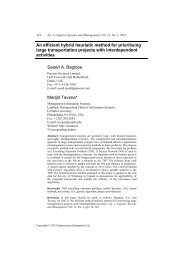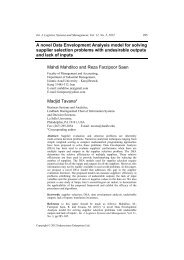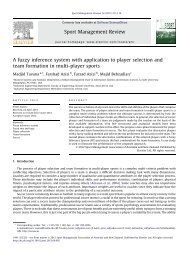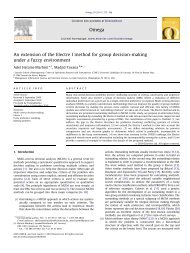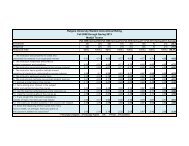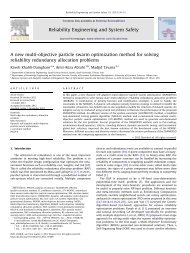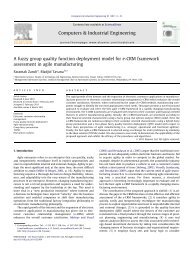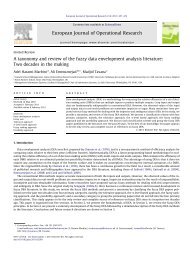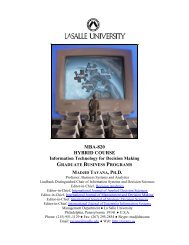A Fuzzy Multidimensional Multiple-Choice Knapsack - Dr. Madjid ...
A Fuzzy Multidimensional Multiple-Choice Knapsack - Dr. Madjid ...
A Fuzzy Multidimensional Multiple-Choice Knapsack - Dr. Madjid ...
You also want an ePaper? Increase the reach of your titles
YUMPU automatically turns print PDFs into web optimized ePapers that Google loves.
460 Ann Oper Res (2013) 206:449–483fourth set of constraints is written for all projects and all time periods of the planning horizons.The fifth set of constraints guarantees that each project is selected in one group in eachtime period of the planning horizon. The sixth set of constraints guarantees that each projectin each group is selected in one time period during the planning horizon. The seventh set ofconstraints guarantees that each project will be selected and implemented within a restrictedwindow of time in the planning horizon. The eighth set of constraints defines the binary stateof the decision variables in the model.Model (5) is a real-world and extended multi-period version of Model (3). In real-worldmulti-objective problems such as Model (5), generating a set of non-dominated solutions onthe Pareto front is preferred.3.2 Phase II: Solution proceduresIn Phase II, an EEC method and a customized multi-objective evolutionary algorithm procedureare proposed to solve Model (5).3.2.1 The efficient Epsilon-constraint methodWe apply the EEC method proposed by Mavrotas (2009) to Model (5) and construct thefollowing model:Max Φ − β × (S 2 /r 2 + S 3 /r 3 )s.t.ω + S 2 = ε 2 , ε 2 ∈ [ ω − ,ω +]θ + S 3 = ε 3 , ε 3 ∈ [ θ − ,θ +]X ∈ Swhere, r i , i = 1, 2, represent the range of objective i and are calculated using the lexicographicpayoff table in Model (5) (i.e., using the ideal or “the most desirable” and nadir or“the least desirable” values of the cost and time objectives). The values of the slack variablesin the second and the third objective functions are different because the scales of thesetwo objective functions are dissimilar and should be put into a common scale. On the otherhand, r i , i = 1, 2, helps in resolving the problem of different scales in conflicting objectivefunctions. The ω and θ have the same definitions as in Model (5). ω + and ω − are the idealand nadir values of the single cost optimization problem (5). Similarly, θ + and θ − are theideal and nadir values of the single quality optimization problem (5). X ∈ S is the feasibleregion of Model (5) andβ is a small positive value. The term (S 2 /r 2 + S 3 /r 3 ) helps ingenerating possible strong non-dominated solutions on the Pareto front in Model (5). Thisterm is subtracted from the objective function to act as a penalty for the objective functionin Model (6). In other words, when the objective function in Model (6) is to be maximized,(S 2 /r 2 + S 3 /r 3 ) should approach zero. r i , i = 1, 2, are ranges of the objective functions andare always positive values. Therefore, the term (S 2 /r 2 + S 3 /r 3 ) can be equal to zero if andonly if the slack variables of the second and the third objective functions (i.e., S 2 ,andS 3 )are equal to zero. In other words, the associated constraints in Model (6) have slack variablesequal to zero (i.e., ω = ε 2 ,andθ = ε 3 ). Therefore, Model (6) can generate solutionsin which one of the objective functions is maximized and two of the objective functions areon the boundary of the solution space. This is a promising condition for generating strongnon-dominated solutions via changing ε 2 ,andε 3 .(6)



